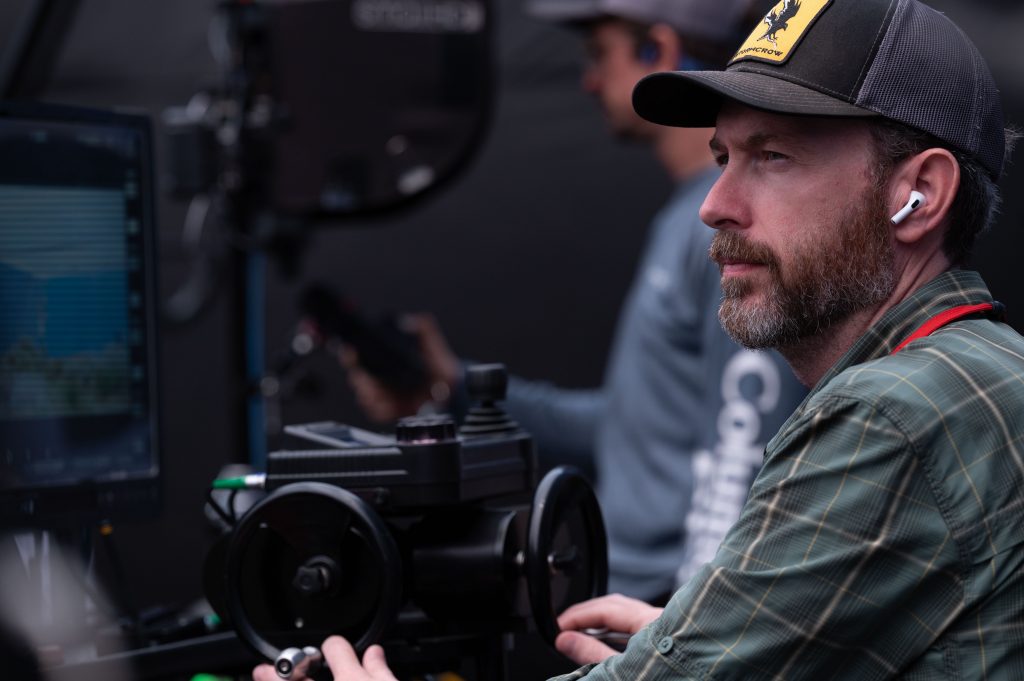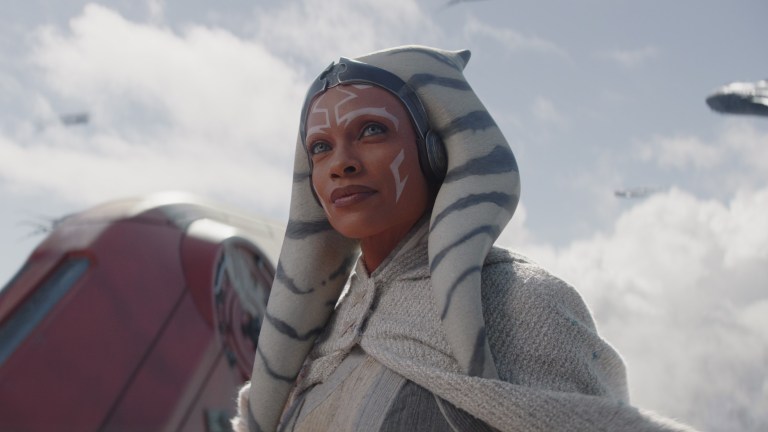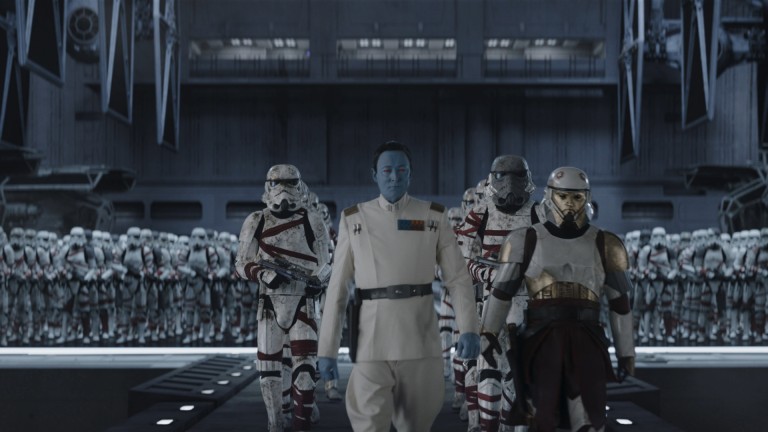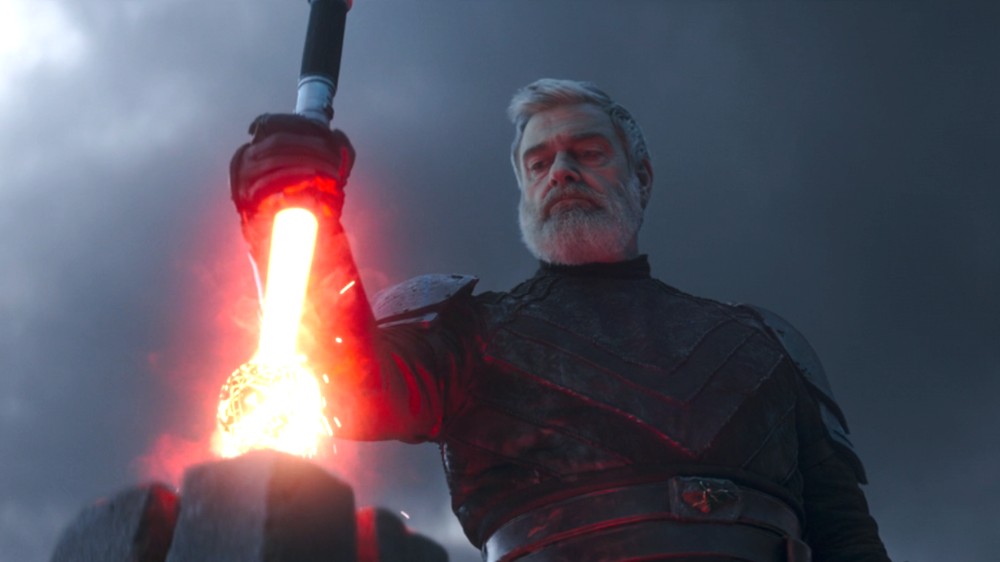
Cinematographer Eric Steelberg never dreamed that he’d end up working on a Star Wars project, but his relationship with the franchise dates back to when he was a baby and his parents first took him to a drive-in to see the film. Since then, he’s amassed a considerable list of credits, the most recent of which is the Disney+ series Ahsoka.
Below the Line spoke with Steelberg about how he believes that the new Star Wars show is much more of an homage to the original trilogy than the prequels, and how he worked with creator Dave Filoni to mostly utilize, to the best of their abilities, technology and tools that were available at that time. He also stressed the significance of having access to the volume and how critical it was to making the show.
Steelberg, who has also worked on the Marvel Cinematic Universe series Hawkeye and a number of other projects, delved into his repeat collaborations with director Jason Reitman, and how the two of them always try to start fresh every time they come to work together again, which is the way that Steelberg always likes to approach any of his projects.
Below The Line: What can you tell me about your relationship with Star Wars growing up?
Eric Steelberg: Star Wars was the first thing I ever saw when I was a baby. I slept through it. My parents took me to the drive-in and I was asleep in the car in a blanket. But that was my first exposure to it, when I was a few months old. I think I’ve been a fan ever since, so it’s been a long time. It’s interesting that I would end up working on something because it was definitely a movie series that I had a deep relationship with growing up.
BTL: I see that you were starting to work as a DP around the time that the prequels came out.
Steelberg: I started a little bit before then in commercials. My feature career took off or started, I should say, yes, around the time of the prequels. I was a fan, but when you’re starting your career, something like that seems very unachievable. A lofty goal, but pretty unachievable. That’s something that really good people do. That’s something that very talented people do. I might be very pleased with my work, but that seemed very unachievable. But it’s a good goal to have, and between that and James Bond movies and probably some other things, those are always aspirational projects that you’d always have in the back of your mind. It was really special when I got the call. It was quite a good feeling.

BTL: I mention the prequels, because, while I remember them getting mostly very bad reviews, one thing you can say about them as compared with the original films is they look great. There’s a very sleek look to them, which the new shows, especially Ahsoka, are a lot closer to that what the original films were. Do you agree with that assessment?
Steelberg: Look, I think whatever anybody takes from it, is fine by me, whether they think it’s reminiscent of the original trilogy or the prequels, it’s all good for me. My personal approach was trying to more closely speak to the style and the feel and the tone of the originals. I think the differences in technology and what we use to film them is largely attributed to probably the similarities you’re talking about between the prequels and the streaming series. But I will say, I think what the prequels did was entirely appropriate and felt great and set a tone for those movies and gave them their own identity, as did the originals, using the best of their early seventies and eighties film technology and lenses and cameras.
Just like now, we’re using, twenty years later, even newer generations of digital technology than they used in the prequels. So it’s been evolutionary. It’s interesting, too, that you’d say that because it’s not a conscious thing. The most conscious decisions we made were in relation to looking at the original three movies for inspiration and tone and really wanting to capture that drama and making sure the visuals were somehow attached to the story in a very similar way that it was in the originals. That it’s more incidental and it’s more serving the story.
I think the prequels got a little stylized, because they had a bunch of new tools available to them, and I think they wanted to use them. We certainly had a lot of new tools available to us, like the volume, which has been talked about a lot. The newer cameras, large format digital. Despite having all that technology, we wanted to try to keep it as simple as possible. When I say we were thinking of the approach of the original movies, I think it’s more what we leaned into versus just because we can do something doesn’t mean we should. That’s what the style of our show was born out of.
BTL: Because of how old I am, I think I saw the original films and then I saw the prequels maybe a year later. For me it was like, this is incredible. But I was also very young, so in my mind it’s always going to be something more than it was because I saw them when I was ten years old. I think that’s not the experience most people have. I like that you’re going back towards the originals. How you perceive something really depends on when you see it and what the technology available is at that time.
Steelberg: Exactly. You had me with an old, I don’t know how to describe it, the more classic storytelling, visual storytelling sensibility with the cutting-edge, bleeding-edge digital technology, both in front of the camera and post-production, and virtually. I wanted to take advantage of that without it being too noticeable or feeling like it’s taking you out of the story, because you’re paying attention to all these new tricks and toys.
BTL: One of the things that is most memorable to me about the show is the idea of character introductions. The first time we see someone, often they’re hooded and looking down and then they look up. Is there a roadmap to, we have a new character, we want to keep them a little bit secret, and here’s how we’re going to first show them?
Steelberg: No roadmap that we spoke about. I think maybe there’s something that’s unspoken when there’s been so much Star Wars prior to our show, obviously. I think there’s an expectation from the filmmakers, the actors, and even the audience about how they want things revealed. You always want to build. You’re also, what you’re doing is you’re selling the importance or the good-bad of a character in that introduction. Is this somebody that’s weighty? Is it a little lighter? Whether it’s a character or a location or a ship.
We had, in episode six, the big reveal of Thrawn’s ship, the Chimaera, I’m really proud of that shot, where we reveal it on that hinge on top of the mountain. Awesome! Being able to do reveals for characters like the ones in Star Wars are so much fun, because it is something you don’t normally get to do on other kinds of projects. We’ve got fun things like hoods and ships and very dramatic shadows and light play, all kinds of stuff that we can do. It’s fun to lean into those stylistic choices that are also very much storytelling choices.

BTL: You’ve done a bit of sci-fi before, but did you enjoy working with these great battle scenes, which obviously are so VFX-assisted with lightsabers fights and everything like that?
Steelberg: It’s so much fun. Well, it’s a weird thing for me for people to call Star Wars sci-fi, and it is sci-fi, because to me it’s so dramatic. It just happens to be more of this space opera. It is sci-fi, but it’s not sci-fi, what I grew up thinking sci-fi was. It was always a little more reality-science-based, more like a 2001 or something like that, or a Battlestar Galactica, or a black hole. Stuff that had more science base. I think Star Wars, even Star Trek was just a little more dramatic and lighter. It always seemed like something different, but anyway, I digress. The only reason I mentioned it is because you mentioned that I’ve done some sci-fi, and I just treated this like a dramatic show, to be quite honest. I try to stay away from those tropes that you would think would happen in sci-fi. I think my work in drama more heavily influenced me on my approach on this.
I approach every project differently, fresh. You’re always going to bring things from other projects and what you’ve learned previously into the new things. What I try to do is not repeat things. You’re taking your knowledge, and obviously your knowledge is always building up, right? You’re always getting a deeper wealth of knowledge to then bring to the next project, so you could say every subsequent project, you’re that much more experienced and trained in the storytelling.
All these things that you’ve done have led up to that moment and then until the next thing. And then it’s picking and choosing the most valuable parts of what to implement in the most appropriate way. Every story is different, so it’s like you’ve got this unconscious amount of knowledge, and then you have to go back and really think about what you can pick and choose that you can use for the next new project.
BTL: Was there any technology in particular that you felt was crucial to making this experience?
Steelberg: I will say that virtual production and volume was pretty critical to making this. The whole project was shot in El Segundo down in Manhattan Beach, here in LA. Yet the whole thing takes place in space and different planets, so you can only do so much with bluescreen and the schedule we had. And there’s this new technology that allows us to do things that are more interactive, that’s more interesting for the actors, more interesting for me with lighting, speaking about the volume.
I think we could not have done the show without that. That’s a significant piece of technology that didn’t exist five years ago, until the first season of The Mandalorian. It existed in iterations and versions, but never implemented or used in in the advanced way that it is now. That was a very new thing for me to have to learn and adapt to. It’s important that, even when you’re using this new technology, not to stray from the basics of cinematography and visual storytelling.
BTL: How do you come in to projects like this and Hawkeye from the Marvel Cinematic Universe, knowing what fan expectations might be?
Steelberg: The easy answer is we’re starting fresh, but like I said before, you’re influenced by everything. I can’t not be influenced by The Mandalorian and what they did, The Book of Boba Fett, Obi-Wan Kenobi, and everything that came before. Then all the movies, all the recent movies. That all goes into the program. It’s all there. Like I said before, what you’re influenced by and what you watch also influences you. So yes, I watch things.
I make sure that I’m approaching the project in a way that feels like Star Wars. That was the thing that every day was going through my head. Does this feel like Star Wars? Are these decisions that I’m making, I know I’m making them, and I’m striving to make them appropriate for the story, in the world we’ve set up and the conversations I’ve had with the directors and Dave Filoni, but does it feel like Star Wars? Is there a unique feel to it that doesn’t make it feel like another sci-fi project, or another space opera or drama. It’s hard thing to put your finger on what Star Wars is or what that feels like. When people have said it really felt like Star Wars, that’s great.
I’m always curious to hear why people say that, what to them makes them think that it feels like Star Wars, because what I think made it feel like Star Wars might be different. The feel of Star Wars, I think, is very individual for a lot of people and maybe it is for me, but I think there’s plenty of us that share what that is. But, I would say that a lot of it, from a visual point of view, shooting it like a drama, letting a lot of stuff play out, wide shots, not super cutty, really interesting shot composition, dramatic lighting. Then, like you said, the way you address characters and the way you shoot characters and aliens and lightsaber fights. There’s not a lot of handheld camera, if at all.
Maybe in some of the more recent movies, they did. For us, it was about staying away from that, so very much going back to the way they did the original movies. There were conversations that I had with Dave Filoni about limiting ourselves to only using the tools they used in the original movies. They didn’t use a lot of cranes. They didn’t use a lot of dollies it, or if they did, it was very straightforward, very simple, sticking to that mentality. Now, of course, we absolutely strayed from that. We did use the modern versions and use them a lot. But even when we had them and were using them, we tried to restrain ourselves as much as possible.

BTL: I want to ask you about someone you’ve worked with a few times and how your relationship has evolved, and that’s Jason Reitman. Not exactly franchise films. This is somebody who, he makes a lot of movies, but they’re all very different from each other.
Steelberg: Well, a little bit of franchise, it’s another franchise lately!
BTL: That’s true. Especially with some of his earlier films, what has it been like working with the same person, and how does that play into the visual vision of each project?
Steelberg: Every cinematographer should be blessed, as I have, to work with a director, or have a long-term relationship with a director, like I have with Jason. It goes back to when we were teenagers. We met when we were teenagers on a friend’s short film. Then when he wanted to do a short film of his own, when he was in college, he asked me to come help. We’ve been working together ever since, on and off, but pretty much exclusively since we did Juno, and then before that we were doing commercials and short films. We’ve learned about storytelling together, we’ve developed our tastes and styles together.
I’ve been obviously able to go off and work with other people and see what else is in the world, which has been really fantastic for me, and then bring those things back and implement them into the projects that we make. We approach every project like it’s the first one we’re doing. I know that might seem weird, but, like I said earlier, every project is different. You take everything you know and you put into it, but, to me, I don’t ever want to repeat myself, at least not in a conscious way. I don’t think Jason wants to either. It’s important that everything has its own identity. We’re about to start prepping for another film and, just the other day, we were talking about having initial conversations about it, like we had never done a film before. I mean, truly, we’re sitting there, we’re brainstorming, trying to figure out how to do these things and tell certain parts of this story. There is a shorthand. You definitely get a shorthand through a long relationship. We know generally what each other is going to say next, or what either of us are thinking with very little dialogue. But it’s the creative aspect I’m talking about mostly. We don’t know creatively where the other person is going to come from or what the other person is going to propose.
Once we get on set, it’s fantastic. Once we get on set, we’re both dialed in and it’s very easy. It’s fast, it’s wonderful, it’s challenging. We challenge each other a lot, but all for the purpose of trying to get the best idea of how to execute something, what’s best for the story. Healthy amount of conflict, healthy amount of healthy conflict, creatively. But it’s great, because we always feel like we end up at the best place for the film. It makes it really rewarding, and working that closely with a director time and time again and seeing the end, the finished product, it’s just super rewarding.
There are a couple directors I’ve worked with multiple times, and it does become increasingly rewarding every project you do, because you are developing that relationship. It’s a very close relationship, as you know, and it’s creatively intimate. When you have something that you’re proud of, it really is your baby from your relationship. It’s the best way I can describe it, and everything that that would normally go into that. It’s been fantastic. I’m proud of every project we’ve done together, regardless of its commercial success. Hopefully, it’s a relationship that continues.
Ashoka is now available to stream on Disney+.





